Using a data set on government debt that was previously unavailable, the article analyzes who bears the burden of government debt. The database includes 12 countries with both debt and GDP data on the countries stretching back over a century. The paper shows that in addition to the level of the Debt/GDP ratio, anticipated future changes in this ratio, as well as the interest cost of covering the debt are important variables affecting the economy. Most nations have seen their government debt/GDP ratio exceed 100% in the past, but not all have sparked a financial crisis. The impact of the government debt/GDP ratio also depends upon the causes, whether the increase is short-term due to war or economy fluctuations, or secular due to unfunded increases in government spending. Reducing the Debt/GDP ratio is a political decision. The government must decide to reduce it by reducing compensation to government employees, recipients of government funding, through higher taxes, or an outright or inflationary default.
The current economic recession has led to unprecedented peacetime deficits and increases in government debt in developed countries. For only the second time in the history of the United States, government debt will soon exceed GDP. The long-run costs and the impact of this growing debt remains highly uncertain and is the chief topic of political debate in the current US elections. While the White House says these deficits are necessary despite the costs, others say the debts impose costs on future generations. Tea Party supporters say government expenditure must be cut.
Unfortunately, very little is known about the historical levels of government debt for different countries of the world outside of the United States and how different countries have dealt with large levels of government debt in the past. Global Financial Data has collected historical government debt and GDP data for the major world economies going back to the 1800s. This paper is based upon the findings of this research.
THE ORIGIN OF GOVERNMENT DEFICITS
The government runs a deficit because it is unable or unwilling to collect a sufficient amount of taxes within any given year to cover its expenditures. For most of its history, the United States balanced its budget except in war time. After the war, the government ran surpluses to pay down the debt accumulated
during the war or ran deficits less than the growth in nominal GDP. A long-term graph of US debt shows rises in the Debt/GDP ratio during the War of 1812, Civil War, World War I, and World War II.
The true cost to the economy of government is the expenditures it makes, not the taxes it collects. Government can either collect taxes today or issue promises (currency or bonds) to pay for its purchases
in the future. When the government increases the money supply, it can cause inflation, and if it issues
bonds, it can “crowd out” the private sector.
Running deficits implies less spending in the future since the government must pay interest or retire
bonds. In some cases, short-run deficits can be justified. Just as consumers or businesses may wish to smooth out the cost of consumption over time, so can the government. If the government is building infrastructure which has long-term benefits, it may borrow money today to be paid off in the future.
Similarly, the government may run a cyclical deficit during a recession which it can pay off when the
economy recovers.
Structural deficits are another matter. A structural deficit that is used to pay for services or transfer
income, unlike capital investment, does not add to the net wealth of society, and implies higher taxes or lower government services in the future to offset the accumulated structural deficits. As Robert Barro has shown, these types of structural deficits can have multipliers less than one because of their impact on incentives and the economic misallocations they create. Unfortunately, a portion of the current deficit
the US is running is structural in nature.
A structural deficit implies structural adjustments in the future; however, it may be difficult to generate the future surpluses needed to pay off this debt for demographic reasons. An aging population implies both a higher recipient to taxpayer ratio and higher healthcare costs for the elderly. Calculations of the implied cost of the entitlement programs the government has promised in the future, such as Social
Security, Medicare, Medicaid and other programs, predict large increases in these costs in the future
without large reductions in the promised benefits. Any attempt to run surpluses to pay back the debt
will require large increases in taxes.
PAYING OFF THE GOVERNMENT DEBT
Paying off the debt is largely a political choice. Who bears the cost of paying off the debt? Is it government workers through lower pay and lower benefits? Is it individuals who see a reduction in government
services or entitlements, either directly through cuts or indirectly through slower growth in benefits? Is it taxpayers who pay higher taxes and fees? Are the additional taxes born by the rich or the poor or both? Is it bondholders who get paid back in inflated currency or don’t get paid back at all?
Government debt as a share of GDP can be reduced or eliminated in a number of ways.
- Run surpluses and pay off the debt as happened in the US in the 1830s, or reduce the debt/GDP ratio by running surpluses as occurred around 2000 under Bill Clinton. Here the cost of the debt is imposed directly on taxpayers with no loss to fixed income investors.
- Run a deficit that is less than the growth in nominal GDP so even if you continue to run a deficit, the
debt/GDP ratio shrinks. The government may have to run a surplus before interest payments in order to achieve this. The lower the interest rate, the easier this is to do. This is largely what happened in the United States between 1945 and 1973. This imposes a lower cost on taxpayers in the short run, but raises the total cost of debt over time.
- Inflate your way out of the debt. If the inflation rate is high enough, nominal GDP can grow faster than the deficit reducing the debt/GDP ratio. This imposes high costs on bondholders who get paid back in inflated currency but relieves taxpayers of the burden. A hyperinflation as in Germany can wipe out fixed income investors. This relieves taxpayers of the interest and principal burden of the debt, but at a high cost to fixed income investors. This solution works well with non-recurring debt (wars), but not with secular social debts.
- Outright Default. This can be done through a currency reform if most government debt is held domestically (Germany, 1948), devaluation if the debt is held by foreigners but in the local currency, or a default on foreign currency bonds. Here the entire cost is born by bondholders to the benefit of taxpayers,
but it becomes difficult to issue new bonds.
Just as the purpose of running a deficit is to hide the cost of government services and expenditures through indirect taxation (inflation tax) or delaying the costs (issuing bonds), so the goal of the government in paying down the debt will be to make the cost as indirect as possible, or to impose the costs on those without political power.
The rest of this paper will look at the experience of twelve major economies to see how they have created
and paid off deficits in the past. Each country’s experience could be the subject of a book, so only the barest of outlines is possible. Nevertheless, these brief histories and their subsequent graphs will give
an idea of the choices the major developed countries now face. We will look at both the debt/GDP ratio and
Interest Share of GDP which equals the benchmark bond interest rate times the debt/GDP ratio.
Historically, there have been several factors which have caused increases in the debt/GDP ratio. One is
war. Globally, the primary examples are World War I and World War II. The two wars were “paid for” differently.
Most governments used inflation to reduce the cost of debt accumulated during World War I and in Germany even used “inflationary default” as a way of eliminating the debt, wiping out bondholders completely. In the United States during World War II, government controlled prices and interest rates which produced a higher return of principal in real terms, but lower interest rates to investors. The debt was paid off by allowing economic growth to shrink the deficits. On the other hand, inflation in Italy and France wiped out their debt after World War II while Germany used a Currency Reform to eliminate its obligations.
Major recessions and depressions also increased government debt, the Great Depression of the 1930s and the current Great Recession being prime examples. Governments tend to grow their way out of the deficits generated by recessions. Wars and Recessions provide quick increases in government debt which can be reversed over time.
The final source of government deficits is the attempt to increase government benefits and entitlements faster than people are willing to pay for them. These deficits are secular in nature and generally require
a restructuring of government expenditures and obligations to stop the accumulation of debt. Because of their structural nature, an outright or inflationary default is unlikely to work. Those who fear the current
deficits will lead to inflation miss this point. Because of the politics involved in making these structural
adjustments, reversing structural deficits is the most difficult of all.
Lenders are willing to tolerate deficits due to War and Recessions because they are temporary events that can be followed by surpluses after the cessation of war or a return to growth. Deficits that occur due to secular increases in government services that cannot be immediately reversed will inevitably lead to a financial crisis that ends in the repeal of these services.
The current growth in government debt is both structural and cyclical. Many people feel that once the government debt/GDP ratio exceeds 100%, a financial vurred. Unfortunately, history shows that governments have to be forced into a crisis to solve these problems, rather than addressing them before the crisis occurs.

AUSTRALIA
Australia saw its Debt/GDP ratio rise steadily from 1850 to 1900 when it established itself as a Commonwealth. By 1900, the Debt/GDP ratio was over 100%. It rose above 100% again during World War I and peaked at almost 200% of GDP during the Great Depression. Significantly, the World War II Debt/GDP peak was below the Great Depression peak, though still over 180% of GDP. Since World War II, Australia has grown out of its Debt, which now represents less than 10% of GDP placing it in one of the most fiscally sound positions of any developed country.
Australia was able to increase its Debt/GDP ratio through 1900 because it was a growing colony. It could borrow money in London with little problem. As it grew, Australia moved its debt burden from international to domestic borrowers and has now almost completely eliminated the foreign debt portion of its government debt. Australia borrowed as it developed its economy, and has grown out of its debt successfully with few periods of high inflation. Returns to fixed income investors in Australia have been high as a result.
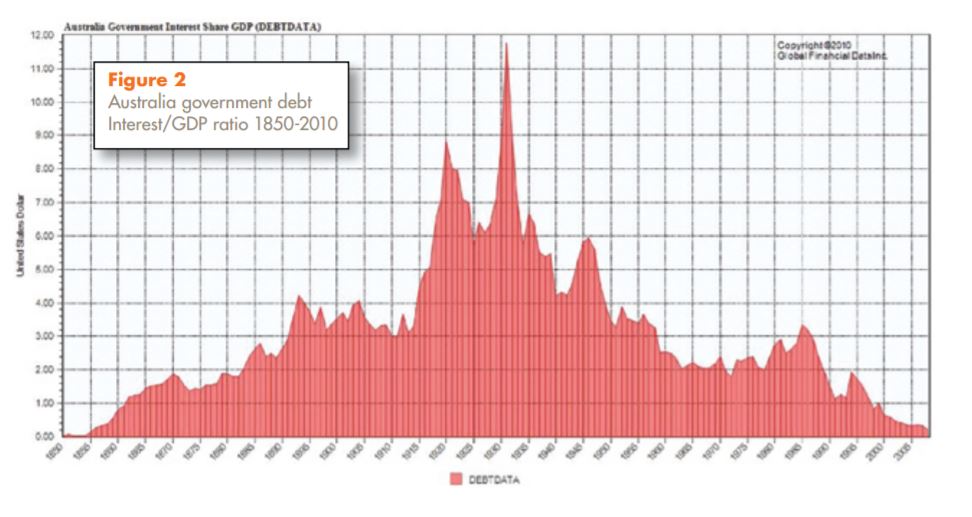
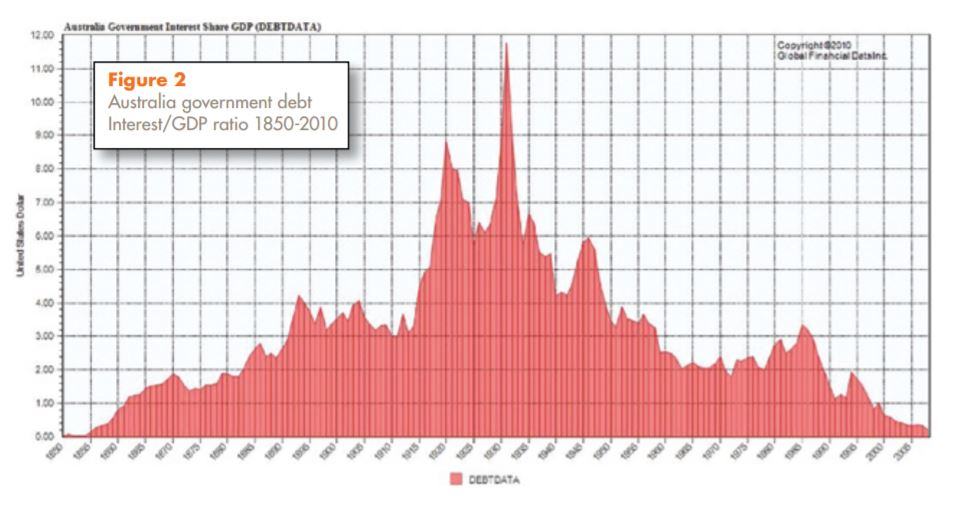
CANADA
Unlike Australia, Canada kept its government debt relatively low until World War I, at which point it rose to 70% of GDP. The debt rose to over 80% of GDP during the 1930s and peaked at over 150% during World War II. The debt declined steadily until the 1970s. Canada reached a debt crisis in the 1990s when secular increases in government services and entitlements pushed debt to over 70% of GDP and the interest cost to over 6% of GDP. Even during World War II when debt exceeded 150% of GDP, the “interest cost” of the debt was only 4% of GDP.
The increase in government debt was clearly unsustainable. The Canadian government was forced to cut back on its spending to eliminate its deficits. Consequently, because Canada put its government finances in order in the 1990s, it has suffered less during the current Recession than other developed countries.
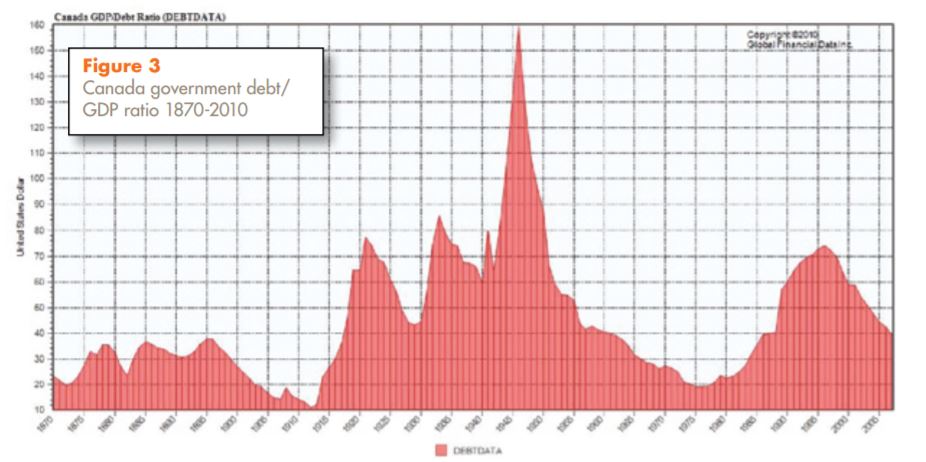
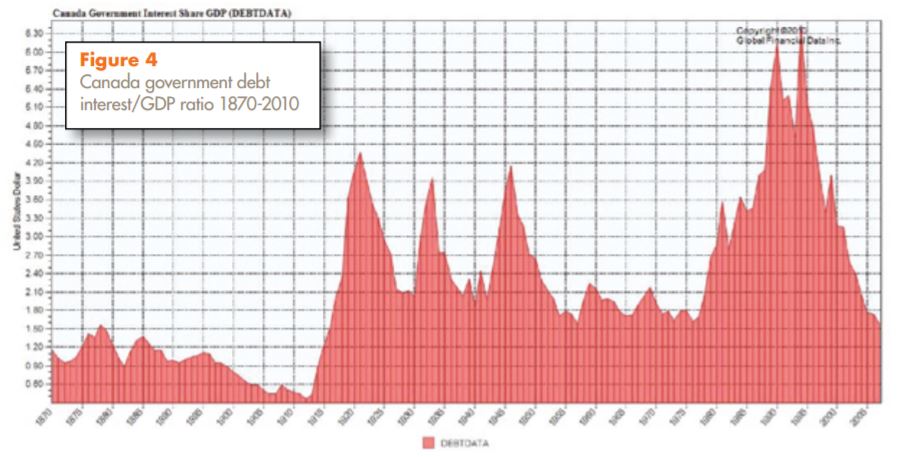
FRANCE
France saw rising deficits during the 19th century until it reached 100% of GDP by 1900. Most of this increase occurred after 1870 when Germany imposed a costly indemnity on France as a result of the Franco-Prussian War. Consequently, when World War I began, France’s Debt/GDP ratio exceeded 80% (vs. 3% in the US). Despite inflation during World War I, France’s Debt/GDP ratio rose to over 200% by the early 1920s. Because of this debt, it is no wonder France wanted to impose a large indemnity on Germany when Germany lost World War I.
By the beginning of World War II, France’s Debt/GDP ratio was down to 100% but shot over 200% during World War II. With no prospect of an indemnity from Germany after World War II, France inflated its way out of its debt imposing heavy losses on bondholders, but to the benefit of taxpayers. This laid the foundations for France’s rapid growth after World War II. Despite the fact that France’s Debt/GDP ratio has grown since the 1970s, it has not reached crisis levels due to high tax rates.
What is important to see about France is that after almost three decades (1915-1945) of having taxpayers bear a high debt cost, the government finally punished bondholders through an “inflationary default”.
Today, this would be more difficult to do because debt is issued in Euros rather than Francs or another local currency, and, as we have seen with Greece, the Euro countries will help countries that could default on their debt because of the costs of the default contagion effect. Nevertheless, there is no guarantee that a country such as Greece couldn’t remove the Euro strait jacket, abandon the Euro, convert its debt into Drachmas and inflate its way out. This possibility is what keeps Greek debt at its current high yields.

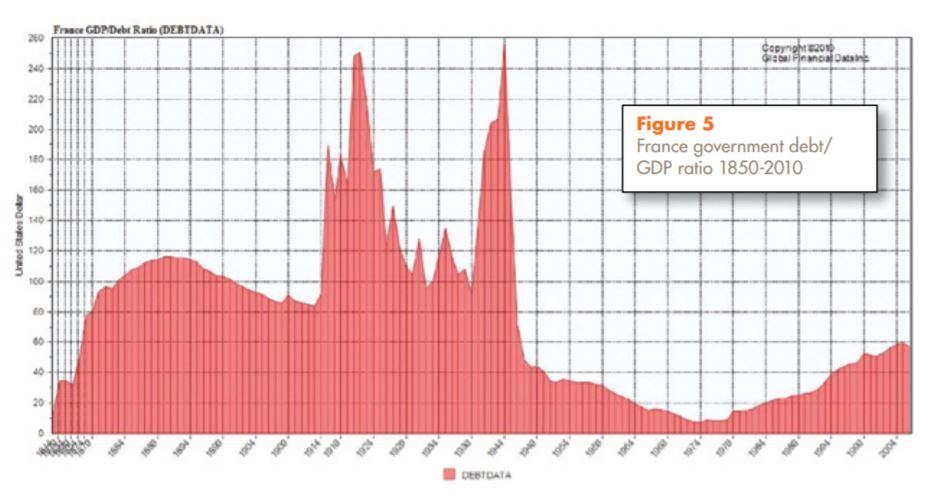
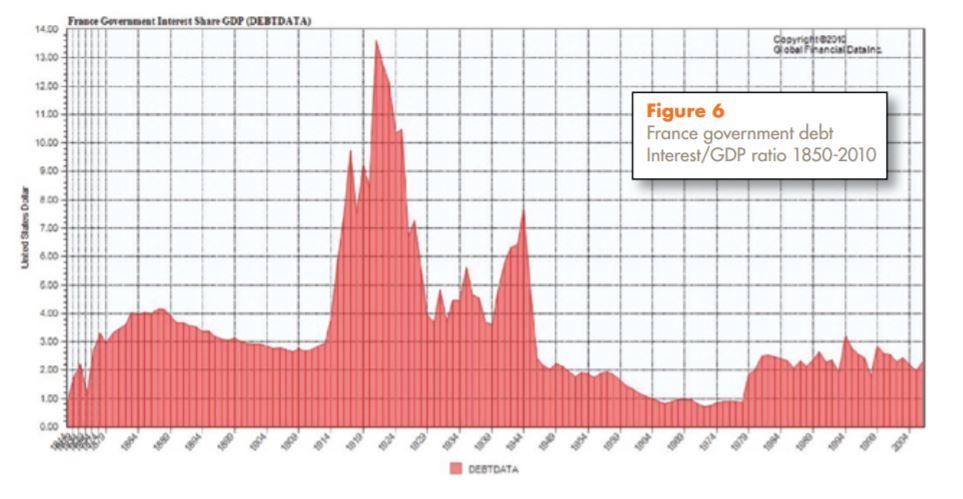
GERMANY
The graphs for Germany are deceiving because there are key periods, during World War I and World War II, when data on Germany’s debts are unavailable. Germany inflated its way out of its debts from World War I through hyperinflation, wiping out bondholders. In 1948, Germany used a currency conversion from Military Marks to Deutschemarks to effectively reduce its debt obligations by 90%.
In part, because Germany twice destroyed the assets of bondholders, it has been more fiscally responsible than other countries since World War II. Although its Debt/GDP ratio has been rising since the 1970s, it remains lower than most other countries. Holders of Confederate and German bonds know that if you lend to the losing side of a war, bondholders can be wiped out.

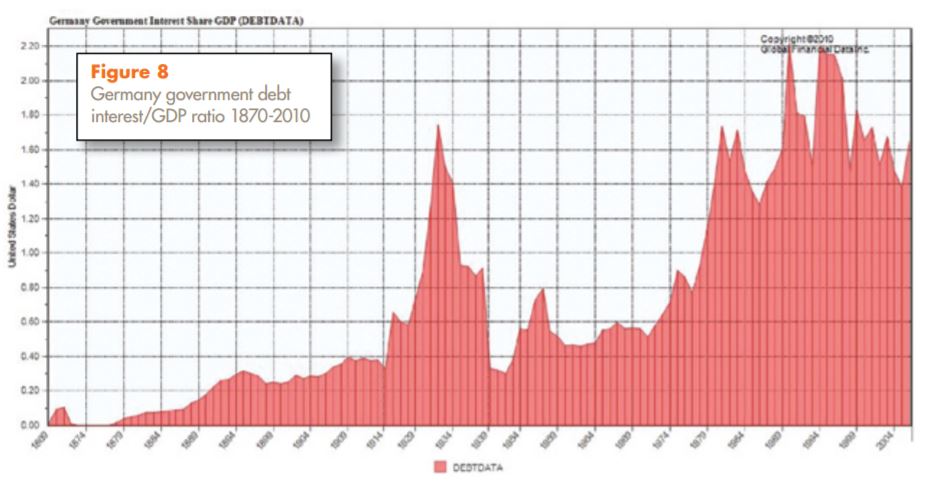
ITALY
Although Italy has had a long history of running deficits, its Debt/GDP ratio has rarely exceeded 100% of GDP by a large margin. Like France, Italy inflated its way out of its debts after World War II, imposing large losses on bondholders. Unlike France, it consistently ran budget deficits after World War II and used inflation as a way of minimizing the true cost. In the 1990s it reformed its finances to stop the Debt/GDP ratio from growing more and upon joining the Euro benefitted from lower interest rates cutting the Interest Coverage Cost of its debt to more realistic levels. Significantly, despite its high Debt/GDP ratio, the yield on its government bonds has not risen as steeply as those of Ireland, Portugal, Greece and Spain.
The lesson for Italy is that persistently high deficits impose persistently high costs on investors even if the debt never hits ruinous levels. Because Italy has persistently refused to balance its budgets, it has provided the worst returns of any G-7 country to both equity and fixed income investors. This is because Italy has had consistently high inflation, yielding low or negative interest rates at the expense of bondholders.
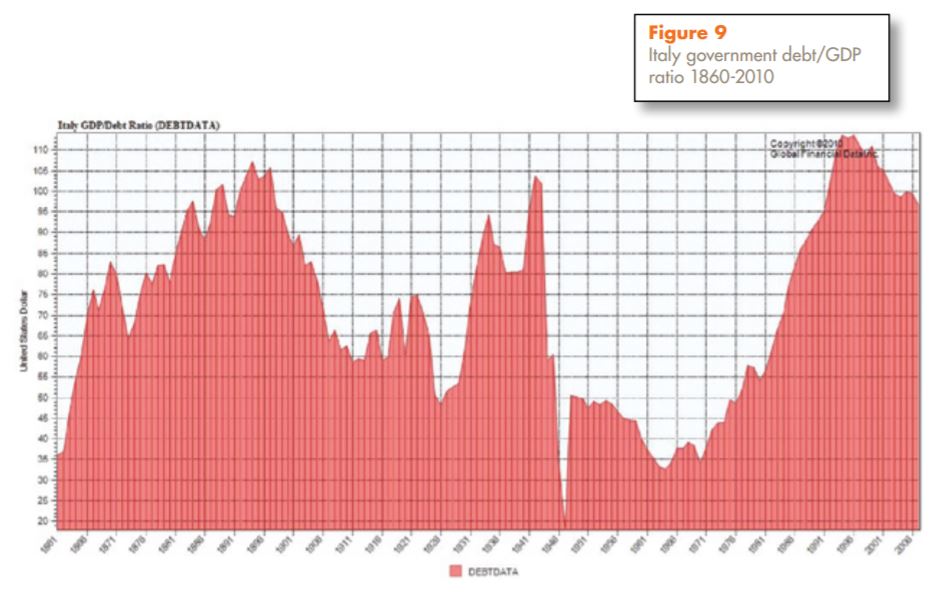
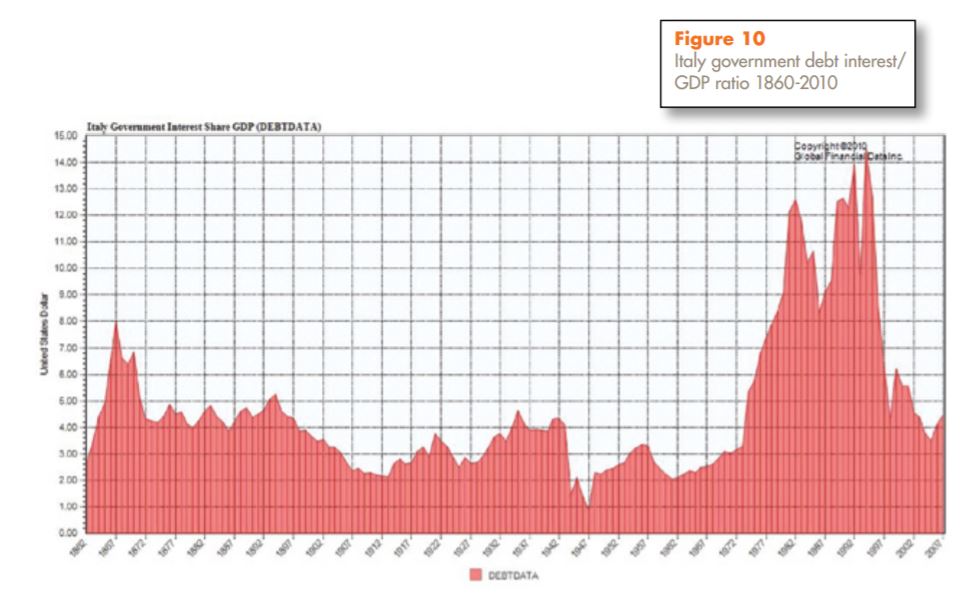
JAPAN
Japan’s Debt/GDP history differs from other developed countries in several ways. The cost of the Russo-Japanese War in 1905 shows up, and as a result of the cost of World War II, the Debt/GDP ratio peaks at 200%. Since the borrowing for the war was almost exclusively domestic, Japan was able to inflate its way out of its debt in the late 1940s, laying the foundations for its economic growth after World War II. Since the 1970s, Japan’s debt has increased steadily, reaching almost 200% of GDP.
Although Japan’s Debt/GDP ratio is approaching 200%, if you look at the interest cost of the Government debt, it was actually higher in the 1980s than it is today. Japan has seen no increase in nominal GDP for almost 20 years, so the Debt/GDP ratio has steadily risen. Japan has been unable to inflate its way out of its debt, but has paid miniscule interest rates to bondholders and absorbed much of the savings within the country.
The government’s debts have crowded out the private sector and virtually eliminated nominal returns to investors. It is no surprise then that Japan has suffered two lost decades of no growth. Japan has boxed itself into a corner in which bondholders either get low returns due to disinflation. If inflation were to return, bond prices would decline and inflation would reduce real returns. With an aging population, no population growth, and low interest rates with savings absorbed by the government, it is difficult to see how Japan can ever return to any level of economic growth. Every country caught in the current financial crisis would be wise not to follow in Japan’s footsteps.
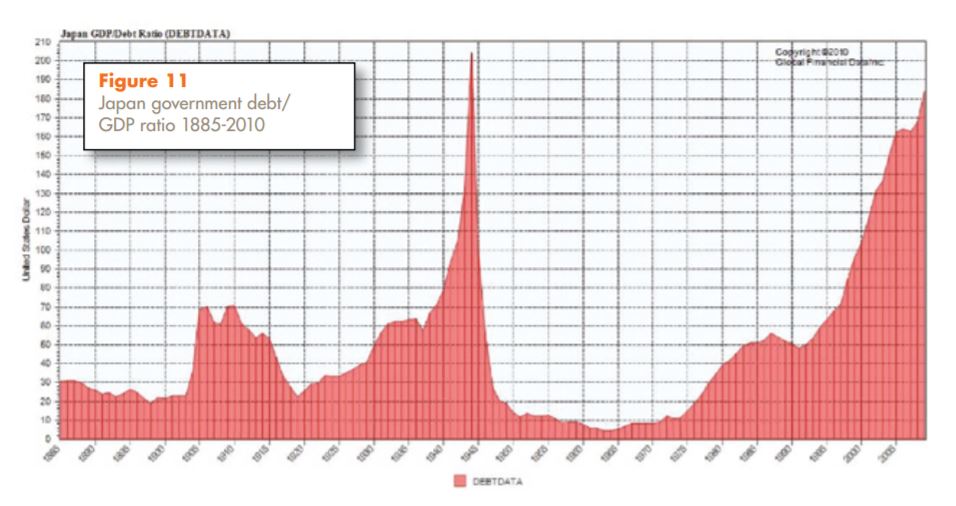
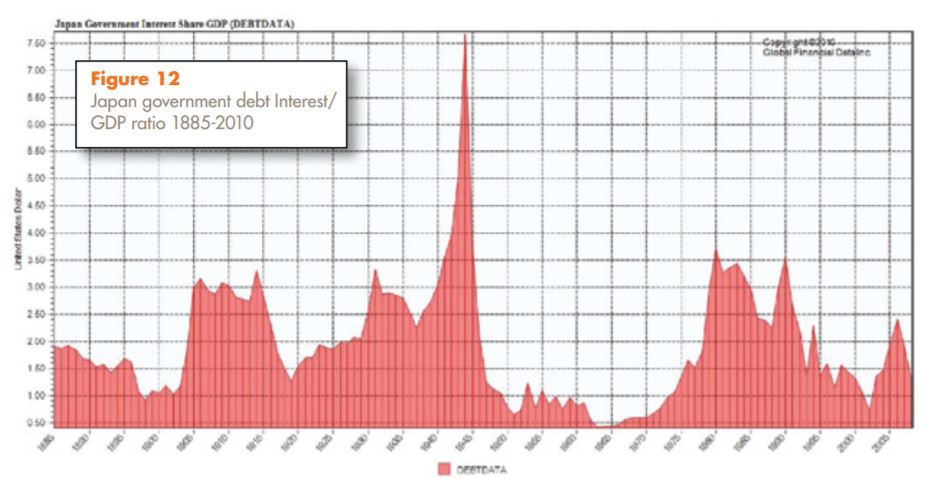
NETHERLANDS
The Netherlands had high debt in the mid-1800s due to the cost of the war with Belgium (1830-1831). The Debt/GDP ratio declined consistently until the 1930s, in part because the Netherlands was neutral in World War I. By the end of World War II, its debt had increased to over 100% of GDP, but through growth and tight fiscal policy, the Netherlands was able to get its debt down to almost 20% of GDP by the 1970s. The Netherlands has had no period in which fixed income investors were significantly punished by the government. Probably, this is because of the Netherlands history as a financial center, and it status as a small, open economy.

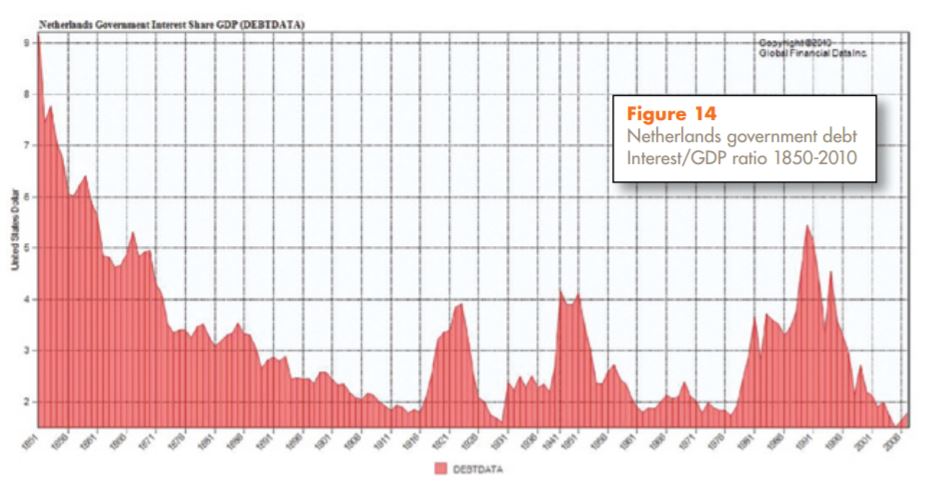
SPAIN
Relative to other countries, Spain had persistently high deficits during the 1800s and defaulted or rescheduled its debt in 1809, 1820, 1831, 1834, 1851, 1867, 1872, 1882 and during 1936-1939. Spain’s debt rose from 60% of GDP in 1860 to over 160% of GDP in 1875 leading to a default in 1882. By staying out of both World War I and World War II, Spain was able to avoid the large debts created by these wars for other European countries. By the 1970s, its Debt/ GDP ratio had fallen to 10% of GDP, but has risen since then as its social policies have changed.
Spain’s debt history is different from other European countries. It had persistent deficits in the 1800s when many European countries were reducing their debts or keeping them small, then avoided the costs of both World Wars. Despite reducing its debt after World War II, adjusted for inflation, bondholders lost money between 1942 and 1985 due to rising inflation and rising interest rates. Inflation is fixed income investors’ worst enemy.

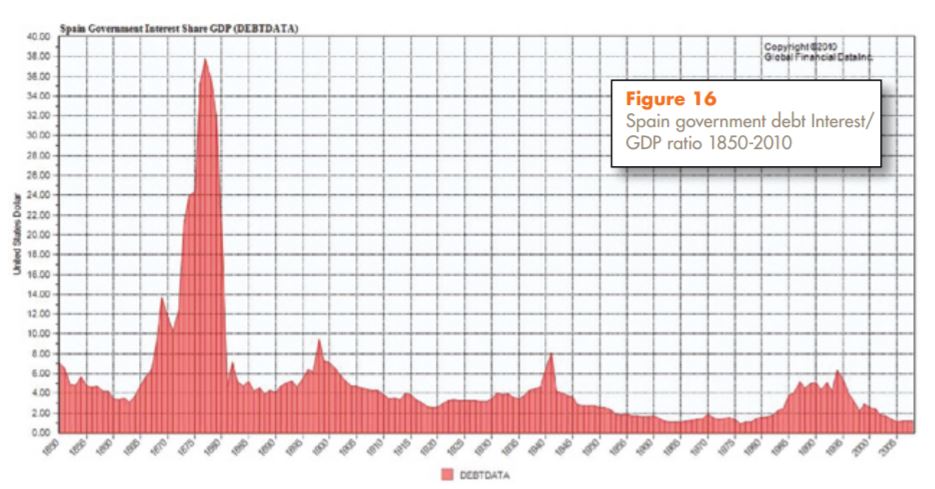
SWEDEN
Sweden, along with Switzerland, is one of the few countries that has never seen its Debt/GDP ratio rise above 100%. Sweden was neutral in World War I and saw its Debt/GDP ratio rise to only 50% during World War II. The most significant increase in debt came in the 1980s and 1990s when large increases in secular social spending increased the Debt/GDP ratio to 75% and the Interest Coverage to 8% of GDP. This sparked a financial crisis in Sweden in the 1990s which led to a reform of its fiscal finances similar to the Canadian reforms. These financial reforms included school vouchers, privatization of pensions and other reforms that the market-loving United States has refused to make. As a result of this, its interest coverage has fallen back to 2% of GDP and the Debt/GDP ratio back to the 40% level.
Sweden and Canada both show that entitlements can be reformed when a financial crisis forces a country to do so. However, making these reforms in a relatively small, homogeneous country like Sweden is easier than in a diverse, large country such as the United States.
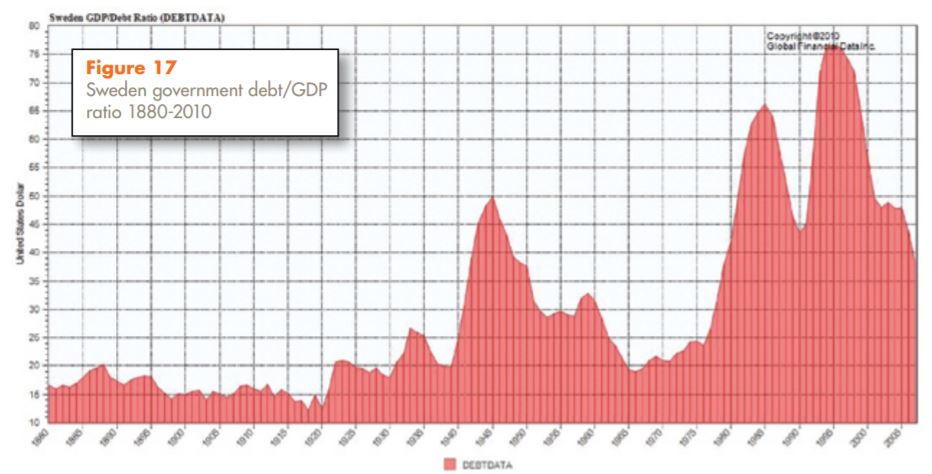
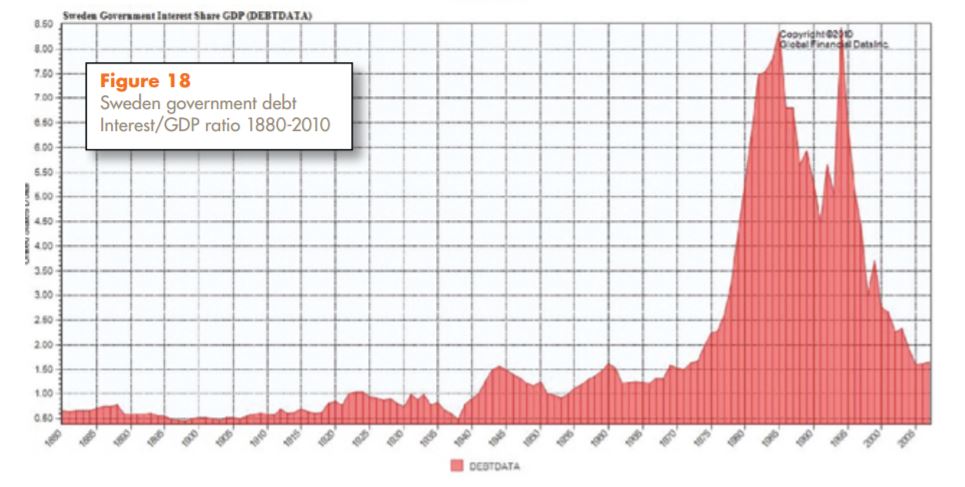
SWITZERLAND
Switzerland also has not seen its Debt/GDP ratio exceed 100%. The only time the ratio exceeded 50% was during World War II, but this ratio has consistently remained below 30% since the 1950s. Switzerland provides a model for the rest of the world for fiscal control and the benefits of a decentralized governmental structure.

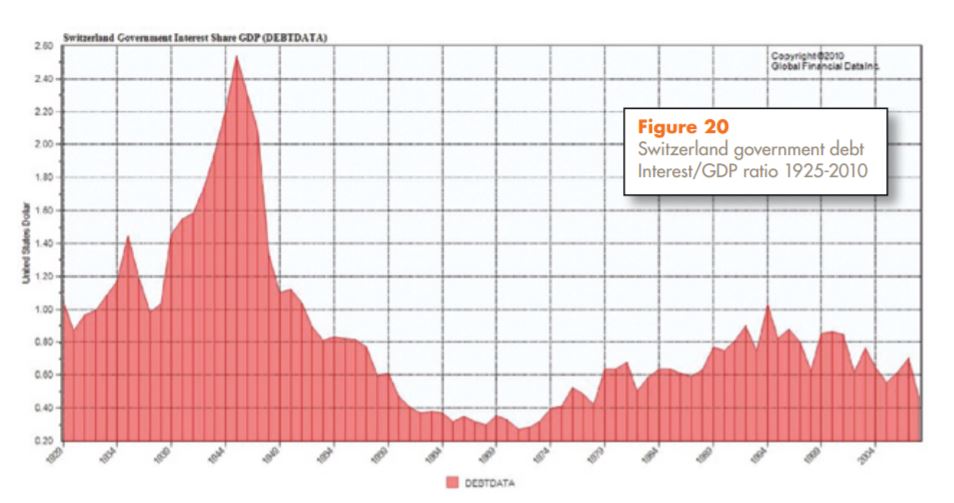
UNITED KINGDOM
The United Kingdom has the longest history of government data available for any country. GFD’s data on government revenues for the UK goes back to 1168 and government debt back to 1689. Both the United States and France inflated their way out of their debts of the 1700s, but the United Kingdom did not. Consequently, its debt exceeded 200% of GDP when the Napoleonic wars ended in 1815 and its interest coverage exceeded 10% of GDP. Under normal circumstances, this would have sparked a financial crisis, but in the midst of the Napoleonic wars, there were few investment alternatives and the Pound Sterling was the reserve currency of the 19th Century. After the wars were over with, the UK signaled that it would meet its debt obligations, which it did, and the Debt/GDP ratio steadily declined until 1915.
The UK could not have carried such a heavy debt load had it not been the world’s reserve currency and the financial center of the world. That the UK was awash with capital is witnessed by the various bubbles that occurred in the 1810s with canals, 1820s with mining and Latin American stocks, the 1840s with railroads, and for the rest of the 1800s with the steady rise in domestic and foreign securities listed on the London Stock Exchange. The United States reaped similar benefits in the 20th Century and today.
Despite declining to almost 20% by 1914, the UK’s Debt/GDP ratio rose to over 150% after World War I and over 200% after World War II. Unlike France, Germany, Italy and other continental countries, the UK refused to pursue an inflationary default after either World War I or World War II. London remained the financial center of Europe after World War I, and recognized the cost of an inflationary default.
No doubt, the debt burden this imposed, equal to around 5% of GDP from the 1920s to 1970s when the UK finally went through double-digit inflation which lowered its Debt/GDP ratio. Someone has to pay the cost of the debt and politics determines this. Continental countries punished bondholders after World War II, but benefited in the long run. The UK respected its debt obligations, but suffered lower growth as a result.
The UK now faces a large deficit which Prime Minister Cameron is addressing with large cuts in spending. It appears to be following the path of Canada and Sweden in the 1990s, though how successful it will be remains to be seen.
The UK shows both the benefits and the costs of being a financial center and having a reserve currency. On the one hand, this enables the country to borrow more as a share of GDP without sparking a financial crisis than would otherwise be possible. On the other hand, it makes it more difficult to default on debt, either through inflation or an outright default. This constrains growth in the long-run since the country is unable to reduce its debt load through inflationary or outright default. These are important lessons for the United States.
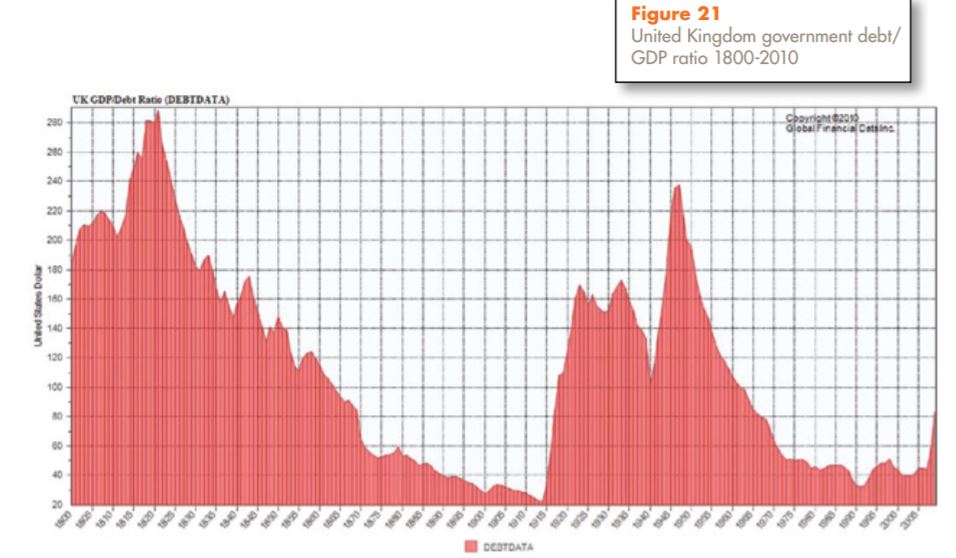

UNITED STATES
The debt history of the US is probably better known than any other country. The US largely paid for the Revolutionary war through inflation with 1000 Continental Dollars converted into 1 Silver Dollar by the end of the war. The Federal Government paid off its debt in the 1830s and despite borrowing 40% of GDP to pay for the Civil War, by 1915, the US had virtually paid off its debt once again. The Debt/GDP ratio rose back to 40% after World War I, back to 40% during the 1930s and to over 120% of GDP during World War II, fell to 35% of GDP by the mid- 1970s and is now reapproaching 100% of GDP. Most European countries saw their Debt/GDP ratios fall between 1995 and 2008, but the US ratio rose due to tax cuts, wars and expansions in government spending leaving the country with a higher Debt/ GDP ratio than most OECD countries when the Great Recession began.
The interest cost of covering the government’s debt has consistently risen. Despite the fact that the Debt/ GDP ratio exceeded 120% after World War II, low interest rates meant that the interest coverage cost was around 2% of GDP. The cost remained around 2% until the 1970s as declining Debt/GDP was offset by rising interest rates. By the early 1980s, this rose to the 5% level and stayed above 4% until the late 1990s. It was during this period of time the bond market began to impose fiscal stringency on the Federal Government.
The US now faces a situation similar to Japan in which the Debt/GDP ratio is rising, but the Interest Coverage cost is declining due to falling interest rates. If interest rates were to rise, the high Debt/ GDP ratio would put the US in the same situation as the UK after World War II in which high interest cost coverage constrained growth. Unless there is a fundamental change to the fiscal policy of the United States, its government debt load could place it in a position of facing Japanese slow growth for a decade or two.
This problem is compounded by the fact that the debt increase is caused by secular growth in government services, not temporary military expenditures or cyclical economic fluctuations. Even if the Bush tax cuts were allowed to completely expire, as neither party wants, the US would remain in a precarious fiscal position. Being a reserve currency with a financial center, as the UK was until World War II, the US cannot easily default by inflation. As has been seen with Japan, if interest rates were to remain in the 2% range, the government’s Debt/GDP ratio could rise to 200% without sparking a financial crisis. However, as the Debt/GDP ratio rises, any sharp rise in interest rates could push the US into a financial crisis which would force the US to make choices on limiting entitlements and social spending similar to what Canada and Sweden did in the 1990s.
Who bears the burden of government expenditures is a political choice. Politicians can decide to impose costs on bondholders directly through an inflationary default, currency reform, or direct default. With US government bonds held so widely throughout the world, this would be difficult. However, until a crisis hits Washington, there is no incentive for fiscal reform. As long as interest rates remain low, the US can pile up debt for another decade, as Japan has done. Whether bondholders want to watch a slowmotion train wreck or will jump the tracks remains to be seen.

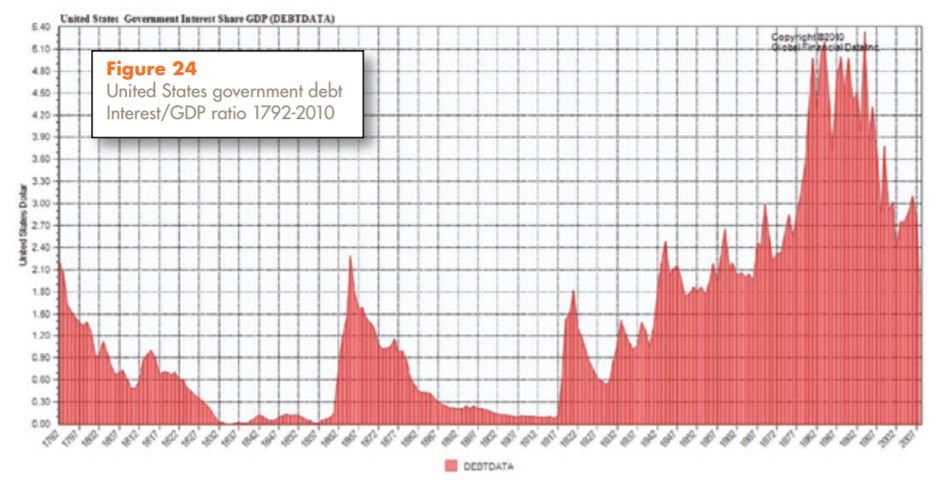
CONCLUSIONS
Our review of debt histories from twelve large countries has been revealing and can lead us to a number of conclusions.
1. There is no ceiling on Debt/GDP ratios. Most of the countries we looked at had Debt/GDP ratios that exceeded 100% without sparking a financial crisis and in some cases, the ratio hit 200%. Whether the increase in Debt is perceived as temporary and will decline when the cause (war, recession) is over, or whether the cause is secular growth in unpaid for government services is more important than the level of debt.
2. The Interest Coverage Cost is more important in sparking a financial crisis than the Debt/GDP ratio. Japan’s low interest rates have been able to sustain rising debt. If the Interest Coverage rises above 5%, this can spark a financial crisis if it appears the level will remain above that level and will continue to rise.
3. Even if high debt does not spark a financial crisis, high Debt/GDP ratios can constrain economic growth making it more difficult to break the burden of the debt. The UK and Japan offer good examples of this.
4. Countries with reserve currencies or countries that are financial centers can find it easier to raise money to cover government debts, but will also find it more difficult to default.
5. Countries that default through inflation, a currency reform or an outright default benefit by relieving themselves of the burden of the debt. The cost is that the country must reestablish itself as fiscally conservative before it can borrow again.
6. Debt/GDP and returns to fixed income investors are inversely related with a lag. Quickly or slowly, government tries to inflate their way out of debt reducing returns to fixed income investors. Fixed income investors got very poor returns globally between 1945 and 1980 after the sharp rise in debt during World War II, but superior returns between 1980 and 2010 as inflation subsided. Rising Debt/ GDP ratios imply low returns to investors in the future either through low (Japanese) interest rates or rising inflation, interest rates and falling bond prices.
7. Higher interest rates can spark a financial crisis that forces the government to reform, especially if the debts were created because of rising secular social costs. War debts are more likely to face inflationary default than rising social costs because the war debts are a one-time non-recurring cost. Since social expenditures largely redistribute income, governments cannot inflate their way out of these costs, but must eventually reform. For this reason, eventually the entitlement problem, which is the basis of the current rising deficits, must be fixed. The only question is whether this problem is taken care of now, or the government waits until a financial crisis forces the government to reform is fiscal ineptitude.
8. The burden of government debt is born by government employees, taxpayers and bondholders. Above all, politics determines who bears the costs. With low interest rates or economic growth, politicians can continue to run deficits. Above all, politics determines who bears the costs of the government’s debt. The interest groups with the least political influence are the ones who will pay the price.

